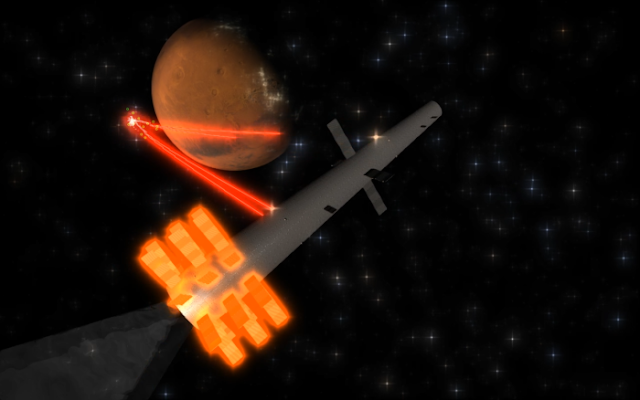Software is pervasive in today's world. We listen to what computers have to say, and the results printed on a screen are considered more reliable and consistent than human intuition. Artificial intelligence has started replacing human minds entirely, known as expert systems. If these trends continue, what do we end up with?
Thursday, 17 November 2016
Wednesday, 9 November 2016
Saturday, 29 October 2016
The Hydrogen Steamer: Stealth Spaceship Concept
Further to the Stealth in Space discussion, we found a type of spaceship perfectly suited to moving about the Solar System undetected. It is called the 'Hydrogen Steamer', and relies on using large amounts of liquid hydrogen.


Here is a discussion of the mechanisms involved, the capabilities and potential designs for the Hydrogen Steamer.
Friday, 21 October 2016
How to live on Other Planets: Venus
Venus is our closest neighbour and Earth's 'sister planet', and yet it is very different from our cool blue marble.

We have a look at some of the challenges and advantages of colonizing this planet.
Thursday, 13 October 2016
How to live on Other Planets: Mercury
Nuclear war. Collapse of the biosphere. Catastrophic global warming.
Space elevators. Whatever the reason, Earth is no longer green and friendly.
Many want to live on other planets, and have the resources necessary to go.
So how will life on other planets look like?
Wednesday, 5 October 2016
The solution to long range space combat
Space Warship Design IV: Complete Examples
In this post, we'll use the numbers we've put together so far, and the baseline spaceship from the last post, to create three 'complete' space warship designs.
Thursday, 1 September 2016
Tuesday, 23 August 2016
Sunday, 31 July 2016
Space Warship Design: A Process
In these posts, we'll go through the process of designing a space warship from A to Z. We'll start from the initial brainstorming session, and end with multiple models easily derived from our baseline.
Of course, many methods exist. Even if you apply the exact same steps described here, you might end up with a very different result. Nonetheless, please use this as a 'worked example' from which you can build your own method, or simply as inspiration if you find yourself in a tight spot!
Of course, many methods exist. Even if you apply the exact same steps described here, you might end up with a very different result. Nonetheless, please use this as a 'worked example' from which you can build your own method, or simply as inspiration if you find yourself in a tight spot!
Sunday, 24 July 2016
You are wrong about nanotechnology
Nanotechnology. The foremost buzzword of the 2000s, holding the promise of a technology that could make anything, with little input other than raw materials. A liquid factory, in a sense. Others saw it as the precursor to the singularity, with resource scarcity becoming a thing of the past.
Let's take a closer look at this mainstay of science fiction.
Friday, 15 July 2016
Friday, 8 July 2016
A Constellation of Warships
So, you've designed a spaceship to fight your wars in space. It can travel between planets, perform multiple missions and is based on NASA reports and real, hard science. You've estimated your nation's military budget, and come out with a fleet capacity and a number of spaceships.
But then... your glorious collection of spaceships fly out in Napoleonic square formation. Or was it pre-WWI lines of battle? Maybe it's Star-Wars-esque clumps of capital ships with space fighters swarming around them. No, you need the ToughSF approach.
But then... your glorious collection of spaceships fly out in Napoleonic square formation. Or was it pre-WWI lines of battle? Maybe it's Star-Wars-esque clumps of capital ships with space fighters swarming around them. No, you need the ToughSF approach.
Thursday, 23 June 2016
Gun Fusion: Two barrels to the stars
To start a fusion reaction, you have to create extreme conditions. A combination of stellar temperatures, incredible pressures and lightning-quick energy dumps have all been tried to create these conditions, with varying degrees of success.
In this post, we'll look at a low-cost, low-energy method of achieving nuclear fusion. It's not Cold Fusion, it's Gun Fusion.
Friday, 17 June 2016
The Nuclear Spear: Casaba Howitzer
When a nuclear technology has been kept classified since the 60s, you know that it is worth looking into. The Casaba Howitzer is one configuration for a nuclear shaped charge, that can concentrate the power of an atom bomb into a narrow cone.
In this post, we'll look at its potential configurations, its advantages and limits, and how it can be applied to both propulsion and warfare.
Saturday, 4 June 2016
Tuesday, 31 May 2016
Why go?
Why aren't we going to space? Where are the fleets of space stations promised in the '50s? Where are the dozens of flights a month the Space Shuttle was designed for? Why has there never been more than 13 people at once in orbit?
Friday, 20 May 2016
Battleships of the Future
Naval warfare has been defined by transitions, all triggered by major advances in technology. Steam power, radar, aircraft... all have led to drastic changes. Today, we are on the verge of another such transition.
Wednesday, 13 April 2016
LWW: Laser Weapon Web
For those who have read the previous few posts, you'll find many arguments and solutions to reducing the effectiveness of lasers. Un-fun by design, they allow for combat at extreme ranges, where manoeuvring becomes insignificant and combat nothing more than a slug-fest.... but what's the logical extreme?

Friday, 1 April 2016
Monday, 28 March 2016
Thursday, 24 March 2016
Wednesday, 23 March 2016
Stealth in Space is Possible
The first thing an aspiring scifi fan looking into the harder end of the spectrum is told is: No Stealth In Space. They're still high off the latest Star Wars, or vividly remember scenes from Alistair Reynold's Revelation Space or James S.A. Corey's The Expanse, but they're given the choice of giving that up or leaving.
This is ToughSF's answer to that.
Saturday, 19 March 2016
Monday, 14 March 2016
Saturday, 12 March 2016
The Big List of Propulsion Failures
When writing a science fiction story, often the author will place the characters inside a spaceship heading towards danger or adventure. For dramatic tension, the reactor explodes! The engines explode! The propellant tanks leak... the fuel explodes!
You have created a vast world, written colourful characters and captivating moments, so why the lack imagination when it comes to failure modes? Hopefully, this post will inspire you to rewrite those dramatic moments.
You have created a vast world, written colourful characters and captivating moments, so why the lack imagination when it comes to failure modes? Hopefully, this post will inspire you to rewrite those dramatic moments.
Friday, 11 March 2016
Innovating in armor
Representations of spacecraft in fiction usually take one of two forms: an armored block bristling with turrets, or a delicate assembly of struts and solar panels straight out of NASA's blueprints.
In this post, we'll discuss how armor can becomes a component of spacecraft design as varied and interesting as the weapons and engines, and the forms it will take can affect the appearance of a spacecraft.
Tuesday, 8 March 2016
The Future of Air War
Aerial combat is a central aspect of modern warfare, and has proven its importance from the Doolittle raid of 1942 to the latest 6th generation fighter unveiled by Russia.
However, this is poised to change as new technologies enter the battlefield. It will have to adapt or be phased out like the battleships. In this series of posts, we'll lay down the foundations and concepts you will need to grasp so that you too can plausibly predict the future of air war.
Friday, 4 March 2016
Electric Cannons and Kinetic Impactors II
In this post, we go through a list of options for the sci-fi writer or worldbuilder to make electric cannons as useful, if not more so, than other weapon systems.
Both advantages, disadvantages and predicted consequences will be looked at.
Both advantages, disadvantages and predicted consequences will be looked at.
Thursday, 3 March 2016
Electric Cannons and Kinetic Impactors
One staple of the science fiction armoury is the railgun. Spinal-mounted or in turrets, it has adorned spaceships from Halo to the Honorverse. However, there are strong arguments against their use in 'hard' sf, such as their relatively low muzzle velocity and large mass penalty.
Here's how you keep your guns.Wednesday, 2 March 2016
The Laser Problem III
We've seen the effects laser weapons have on space combat, and the consequences of deriving laser power from rocket engine power output. As promised, in this post, we'll go through a few solutions authors and game designers have to avoid cornering themselves into unfun combat systems.
Tuesday, 1 March 2016
The Laser Problem
One of the most important decisions to be made during worldbuilding is choosing the pace of the events to unfold. This is usually the frequency of major events, modified by the focal point of the narration (an individual, a group, a government or a civilization as a whole).
In science fiction, the frequency of 'major events' generally has an upper limit, that is how long it takes for the characters to travel to another location.
Saturday, 27 February 2016
What is Tough Science Fiction?
Any science fiction enthusiast has faced multitudes of worlds, built for games, movies or stories, that fall apart the moment you take a closer look at them.
They might be your favourite worlds: Star Wars, Halo, or lately, The Expanse, so this isn't necessarily a bad thing. However, they force the audience to suspend disbelief more than they should, creating an extra level of difficulty when it comes to hooking them in.
Subscribe to:
Comments (Atom)






























